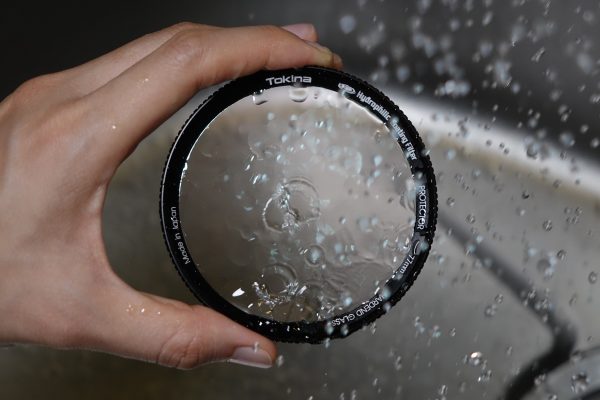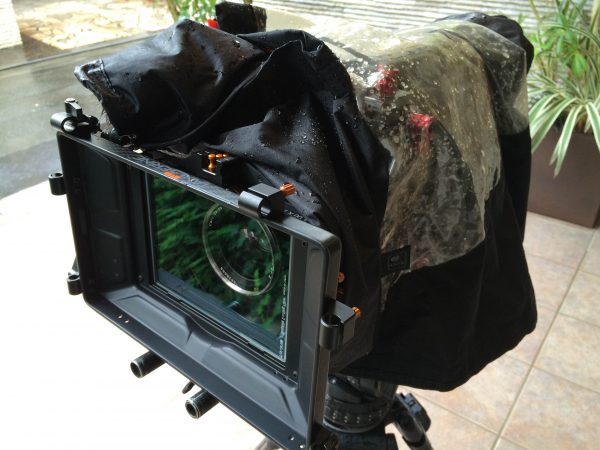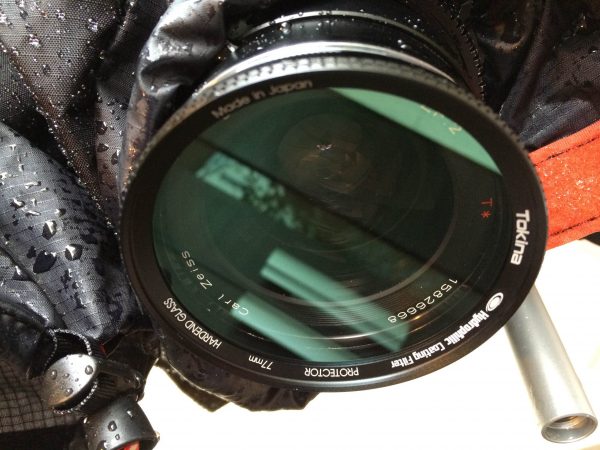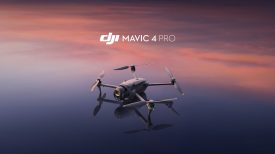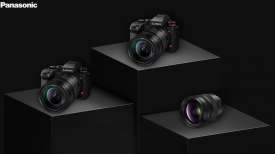By technical editor Matt Allard:
If you ever shoot in wet or showery conditions then this filter was designed for you. We first saw the Tokina’s hydrophilic filter back at IBC 2013 and after almost two years of waiting they are finally available to buy.
If you are not familiar with hydrophilic technology let me explain how it works;
Water-droplets on glass are formed by surface tension and adhesion. Only once the weight of a water bead exceeds this tension does it trickle down the glass. As water trickles down it leaves a trail behind. You can see this effect on a regular window every time it rains.
The coating of the hydrophilic filter is different. Water drops falling onto the surface are transformed into a thin film, instead of accumulating as beads. In the case of this filter it means that water simply runs off the surface of the glass and you don’t have to keep wiping it off.
To do this requires that the filter is ‘charged’ for several hours. Exposure to ultraviolet light sources causes a reaction that gives the filter its hydrophilic properties.
A combination of the hydrophilic and catalytic layers on the filter that not only helps disperse water but also keeps the filter free from dust and dirt.
Hydrophilic technology has been around for quite some time. Japanese company Murakami has been manufacturing car side mirrors with a hydrophilic layer for Lexus. The hydrophilic layer on the side mirrors doesn’t need to be re-charged as they are exposed to UV light all the time during day to day driving. Tokina working with Japanese broadcaster NHK have taken this same technology and re-engineered it to work on glass filters of a much higher optical quality.
The hydrophilic coating of the Tokina filter is permanent and does not need to be reapplied. The aim is to provide a clear view through your lens under a variety of bad weather conditions. The filters are made out of chemically enhanced optical glass which is claimed to offer four times the strength of normal optical glass.
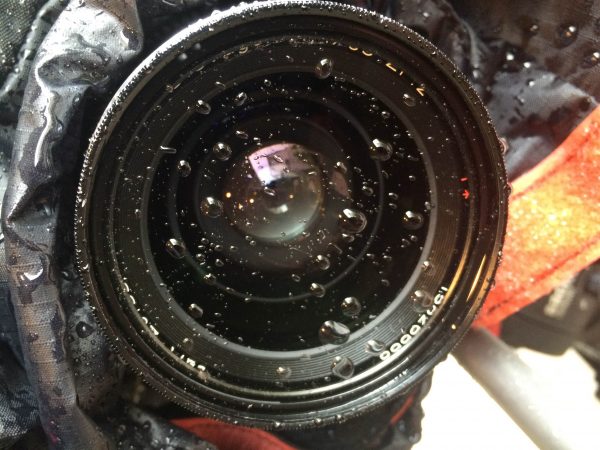
A simple filter that can prevent nasty water drops ruining shots in bad weather is something broadcasters have been wanting for years. It comes as no surprise then that the Tokina filter is already gaining popularity for sports coverage and other outside broadcaster applications. ESPN and the Golf Channel are apparently already using them on large scale productions.
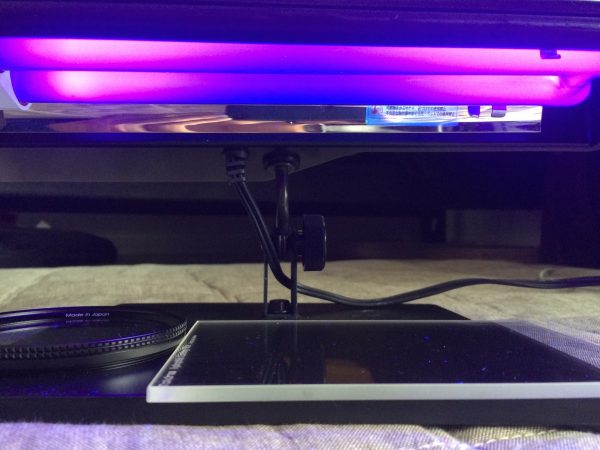
The obvious ‘catch’ with these filters is the need to be re-charge them with bright sunlight or under a UV light to keep their hydrophilic properties. A UV light is not something that you tend to have just sitting around at home. The cheapest solution is to buy a UV light that is commonly used for drying nails. You can find these on Amazon and other websites for around $30 US. You have to charge the filter up when you first get it for at least 4 hours under a UV lamp for it to work correctly. Once charged Tokina claims the filters can operate for 2-3 days and still work well before they need to be re-charged.
I first tried re-charging them naturally by placing them on a window ledge. Tokina suggests this takes at least 6 hours, but as it was an overcast day it didn’t appear to work. I haven’t had a chance to see how well the re-charging works if you expose the filters to bright sunlight, but my guess is that if you live in a country that gets a lot if UV like Australia or the Gulf states then you will have better luck (although possibly less need for the filter in the first place). I then charged them with a UV light which worked just fine. For best results I found that you are better to charge the filters up after each use.
Once you have used the filters make sure you don’t put them away in some dark place where there is no sunlight. The hydrophilic effect will eventually fade over time if your not using the filters. You need to re-charge them every now and then to keep them ready to use at all times.
For major broadcasters, production companies and rental houses, Tokina is working on a large UV re-charging station so that a large number of hydrophilic filters can be charged at once.
You also need to be very careful when handling or cleaning the hydrophilic filters. Never use any type of cleaning substance on the glass as this will damage the coating. Tokina recommend that you handle the filters with latex gloves and wash them under cold, clean water to keep them clean.
Until now the main option for dealing with rain was to use a Rain Deflector that keeps lenses clear by using a high speed rotating clear filter. This works by spinning the glass at a high enough speed to create a vacuum. In rainy situations the centrifugal force together with the vacuum effect, continually spin off all droplets (apart from a tiny one dead centre which is too small to be seen on screen). The problem with using these types of systems are they are expensive, noisy, and they need to be powered. Also you can’t use them in conjunction with any other filter.
I tested out the 77mm round filter and the 4 x 5.65 inch Hydrophilic filters to see how they performed in rainy conditions. We’ve previously seen the filter work well in a controlled environment, but I wanted to test it in the real world.
Below you can see a series of tests I did with, and without the Tokina Hydrophilic filters to see just how well they performed in the rain.
From my short time using the Hydrophilic filters here are my initial thoughts. The first thing you should be aware of is that these filters do not miraculously keep every single drop of water from getting to the filter, they just disperse it in a better way. The rain still hits the filter, but instead of the water forming as big nasty droplets, it is spread out evenly across the glass. The filters do a pretty good job of keeping your image crisp but in very hard rain you can get a sort of running water effect over areas of your image. In fairness I only encountered this effect when I was pointing the lens straight up into heavy rain and it isn’t something your likely to make a habit of. For the most part the filters performed very well and from the above video you can easily see the difference between a Hydrophilic filter and no filter at all.
To see if there was any colour shift and decrease in visible sharpness when using the Hydrophilic filters I conducted another quick test. The filter did a pretty good job at maintaining colour accuracy, with just a slightly warm shift to the image. As to be expected with a filter of this kind I found a slight decrease in sharpness.
I also decided to test the filters at night in the rain to see how they would perform. I was shocked by results I got. In short they looked horrible. Unlike during the day, at night, the filters ability to cope with both rain and bright car headlights was severely compromised. As the water is getting spread over the filter the camera is actually shooting through a film of water. Couple this together with bright lights and you get a strange ghosting effect where the image turns very soft and makes the footage virtually unusable. The bokeh you get also looks like a sort of snowflake and is not pleasing at all. The hydrophilic filters were obviously designed for outside broadcast events that are almost always conducted during the day. You can see the results yourself in the below video.
Final thoughts:
The Tokina hydrophilic filters are definitely an interesting solution to the old age problem of dealing with water on your lens, however they aren’t a miracle device. The obvious drawback is that they need to be re-charged on a continual basis to remain effective. Most individual shooters are not going to want to carry around a UV light to do this. For major broadcasters, particularly sports networks these filters will quickly find a home. There is nothing worse than sitting at home watching a sporting event on TV where the camera lens has been covered in water and made the image very distracting to watch. From golf, to Formula1. to football, the hydrophilic filters will undoubtably be used to great effect. For the individual shooter it is still a tough sell given the drawbacks, but next time your filming out in the rain, you may just wish you had one.
The Tokina Hydrophilic filters are available in round sizes 77,82,86,95,105,112 and 127mm. In square sizes you can get 4 x 4 inch and 4 x 5.65 inch filters. Prices start from $405 US for the 77mm up to $550 US for the 127mm.

